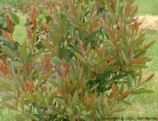
|
New growth of Callistemon
pallidus. |
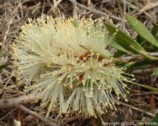
|
This Callistemon was
supposed to be C. salignus - and it may be, but so far it has remained
very dwarf. I ordered a seed packet of C. salignus and got
three distinctly different kinds of plants out of it. |

|
Callistemon sieberi
is one of the very hardiest Callistemons, and has cream flowers
and small prickly leaves. |
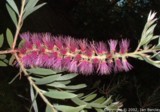
|
Callistemon 'violaceous'
is not considered to be a real species. However, I have three plants
in my garden that are all supposed to be C. violaceous, and they
are all very distinct from each other. This is the first one that
bloomed and it was very showy. They are not hardy enough to make
it through severe winters without freezing to the ground. |

|
New growth of Callistemon
viridiflorus. |

|
Callistemon 'Woodlander's
Hardy'. This plant looks to me like C. subulatus. With
due respect to Woodlander's, I am not sure where they get off putting their
name on something they did not specifically develop, just because they
do not have the resources at hand to positively idenfity it. |
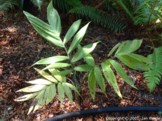
|
This is probably Chamaedorea
radicalis X C. microspadix. Both species are hardy here.
The seed came from a plant of C. radicalis, but the plants form
suckers (uncharacteristic of C. radicalis), and have wider leaflets
than C. radicalis. |
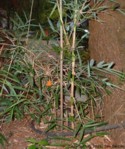
|
Chusquea valdiviensis.
This scandescent bamboo is capable of climbing up to 80' as long as it
has support (here it has been planted under trees). The outer branches
arch up and hang way down - it is a most exotic looking plant. |

|
Clerodendrum bungei
flowering in October. This was the first time it flowered in 2001;
in 2002, it flowered much earlier in the season. |

|
Colquhonia coccinea
var. mollis, a plant that can hopefully substitute for the red-flowered
Salvia
sp. in areas too cold for them to grow. Maybe not though, since it
didn't get large enough to bloom in 2002. |
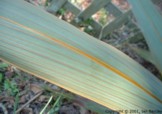
|
Leaf of Cordyline indivisa.
C. indivisa should never be confused with C. australis, because
the leaf of C. indivisa is much broader and has a very prominent
orange midrib. The main crown of this plant froze in a very hard,
early frost on October 31, 2002. However it has a smaller side crown
that is still in tact. |
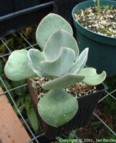
|
Cotelydon orbiculata
var. oblonga is cold-hardy to zone 7 but would probably deteriorate
if left out in our winter rains if left out for the winter. |
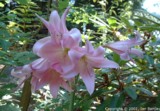
|
Crinum X powellii
has done very well in my garden, blooming in August in dry partial shade
with no special care. |

|
Cyathea cooperi is not
hardy here and must either be kept in a pot or protected heavily during
cold weather. Photo by Sam Castro. |

|
Cyathea cooperi can
be distinguished by the true C. australis by the presence of white
scales on the croziers (along with the brown hairs), as shown here. |
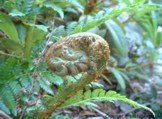
|
The deciduous Cyathea dregei
from South Africa may be the hardiest tree fern. |
